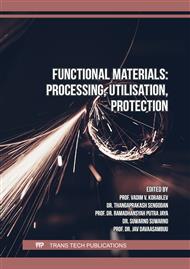p.117
p.127
p.135
p.145
p.151
p.157
p.165
p.173
p.179
Reproducibility of Properties of AsxSe1-x Glasses on the Synthesis Temperature
Abstract:
AsxSe1-x glasses with x from 0,05 to 0,55 were prepared at two melting temperatures, 700 and 850 °C. Batch materials from several suppliers were used for glass synthesis. Density and IR transmittance of glasses were measured. It was found that data for density of glasses prepared at 700 °C have sufficient scatter, so dependence of molar volume on composition is not smooth. Data for glasses synthesized at 850 °C are in good agreement with reference ones. According to data of IR spectroscopy the main impurity in glasses is oxygen in several molecular forms. Oxygen gets in glass together with arsenic. Its content can be noticeably decreased by the heat treatment of As at from 300 to 350 °C and Se at 310 °C before weighting and by the heat treatment of batch at 200 °C before the sealing of silica ampoule. Optical quality of glass samples is good enough for the use them as IR transparent material for lens manufacturing.
Info:
Periodical:
Pages:
151-156
Citation:
Online since:
March 2023
Keywords:
Price:
Сopyright:
© 2023 Trans Tech Publications Ltd. All Rights Reserved
Share:
Citation:


